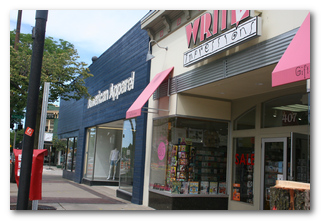If you want retailers, you have to play by their rules
 Sometimes it seems like retailers and planners are at cross purposes.Planners look to the future and embrace new practices and concepts like form-based codes, transit-oriented development, mixed-use and place making. We are comfortable with a degree of uncertainty.Retailers look to the past – to what has worked and what hasn’t – and in data they trust.Reading Robert J. Gibbs’ Principles of Urban Retail Planning and Development you’ll realize that the retailers hold all the cards. If you want them in your town, you’ll have to play by their rules. Verbatim, from the book, those rules are:
Sometimes it seems like retailers and planners are at cross purposes.Planners look to the future and embrace new practices and concepts like form-based codes, transit-oriented development, mixed-use and place making. We are comfortable with a degree of uncertainty.Retailers look to the past – to what has worked and what hasn’t – and in data they trust.Reading Robert J. Gibbs’ Principles of Urban Retail Planning and Development you’ll realize that the retailers hold all the cards. If you want them in your town, you’ll have to play by their rules. Verbatim, from the book, those rules are:
- Retailers must sell merchandise and earn profits
- Sustainable shopping centers and urban centers sell the goods and services (brands and price points) that people desire and need
- Convenience retailing needs to be convenient
- Street-front retailing requires on-street parking
- Form follows freeway and finance
- Anchors are essential for downtowns and most shopping districts
- Shopping centers over 30,000 square feet in area require anchor stores
- Parking must be well planned and convenient, but it does not need to dominate the center
- Time is the new luxury
Not a rule but a fact of life: Anchor stores are so essential that many of them pay no or little rent.Gibbs tells us we can’t dream up store sizes, merchandise mixes and critical mass that bear no resemblance to what retailers know work.“Placemaking cannot transcend or replace the fundamental needs and economic considerations of retailers,” he said.Gibbs offers lessons for planners in both developed and undeveloped communities.Undeveloped areasPlanners want to follow contemporary urban design concepts like mixed, dense uses; store fronts on the sidewalk with parking in the back, and transit-oriented development. Retailers have a limited array of configurations that they know work and none of them look much like what planners seek.“Form follows rent,” Gibbs says, adding that urban mixed use can cost 20-25 percent more than a strip center but doesn’t necessarily generate proportionally more rent from businesses or upper-story residents. Stacking residential over retail adds 20-25% to the cost of the residential units.Community centers* present an opportunity for more urban design qualities, with “streets” and, in high density urban areas, the possibility of stacked stores.*250,000 to 500,000 square feet, drawing from a four to six mile radius with a population of 50,000. It may be anchored by a discount department store, home improvement store or supermarket.Planners creating a platted town center should think like a mall. Stick to building standards like zero lot lines, first floor windows and consistent signage. Make stores maintain common hours and contribute for shared marketing and maintenance. Limit ground floor uses to retail and dining.Retail in developed areasMore and more people want to live in an urban area, Gibbs says. “As a result, downtowns and other urban areas have an opportunity to experience a rebirth as the centers of regional commerce.” Tourism also draws people: “Shopping is the most popular activity of American tourists … in the United States.”Traditional downtowns CAN attract retail but, to do so, they have to think and operate like a mall.Assemble land. “Getting prime businesses to locate in historic downtowns is more a matter of sufficient space -- a supply issue – than of finding tenants – a demand issue,” Gibbs says. Plan to have properties available for expansions and make sure existing property is maintained.Simplify the process. You’re competing with shopping centers whose codified standards streamline plan and/or zoning approval and permits and help you survive inspections.Data are your friend. Gibbs suggests that planners battle data with data to attract retail. Use “long term, objective, cost-benefit metrics:” Weather data, parking counts, pedestrian counts, rental rates, vacancies. Use them as tools to improve performance.Standardize hours. It’ll be like wrangling cats, but try to establish common days and hours of operation in your downtown, ideally mimicking those offered by malls.Build amenities that help stores achieve their sales goals. Planners like seating and clocks. Retailers don’t. They do like trees, when they shade customers but no so much when they block signs. Sidewalks are important so long as they are attractive, clean, roomy and safe, but their features should not pull focus from storefronts. Lighting is important enough to justify a coordinated public-private loan or grant program for lighting, Gibbs says.“Although up-to-date, well-designed and maintained public spaces are essential to sustainable shopping areas, their contributions to retail sales are generally overrated.”Making parking visible. Parking ratios are all well and good but visibility and proximity are important, too. If they can see their destination, shoppers will park further away than if they can’t.Gibbs’ book offers a number of case studies in cities including Pontiac, Birmingham and Bay City.
